
Dr Shams CLI Amputation Prevention Case
Page Navigation
https://www.youtube.com/embed/Bcx7vDj1ONw?rel=0Dr. Joseph Shams has a long and distinguished career as an Interventional Radiologist. Dr. Joseph Shams leads the team’s compassionate, patient-centered approach to endovascular care to help you feel at home while you get back on your feet.
Patient History and Consultation
- 93-year-old female who presents with painful, ruborous, cold right toes and focal, spotty gangrene at the nail bed of the right big toe. The patient states that “she can barely walk” and “she cannot sleep at night” because of the severity of the pain. The patient underwent intervention at an outside facility with SFA stenting several years ago. She was seen at another facility last week but no intervention was performed.
- Past Medical History: HTN, ESRD on HD since 2018, Asthma
- Social History: denies alcohol use or cigarette smoking
- Allergies: Clonidine
- Medications:
- Flovent
- Albuterol
- Montelukast
- Aspirin
- Diltiazem
- Enalapril
- Sevelamer
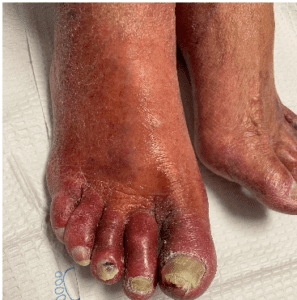
Physical Examination
- A&O X3
- VS: Pulse 58/min and regular, BP 133/59, RR 16/min, Temp. 95.3F, O2 sat. 98% on RA
- Lower Extremity Exam: cold, ruborous, right toes which are exquisitely painful to touch. Delayed capillary refill in toes. Punctate area of gangrene in the nail bed of the right big toe.
- Pulse Exam: 2+ palpable femoral pulses bilaterally. Non-palpable popliteal, dorsalis pedis, and posterior tibial artery pulses bilaterally. Distal right pulses are dopplerable with weakly monophasic signals.
- ABI at rest: right 0.4, left 0.6
Treatment Plan
- Plan
- Medical evaluation.
- Routine lab work.
- Arterial Ultrasound exam.
- Treatment
- Right lower extremity angiogram and revascularization.
Arterial Ultrasound Exam
- Severe, 75-99% stenosis is noted at the proximal superficial femoral artery.
- Moderate, 50-74% stenosis is noted at the origin superficial femoral artery.
- Severe, 75-99% stenosis is noted in the mid popliteal artery.
- Chronic atherosclerotic occlusion versus attenuation of the posterior tibial artery and peroneal artery.
- Severe stenosis was noted at the proximal anterior tibial artery.
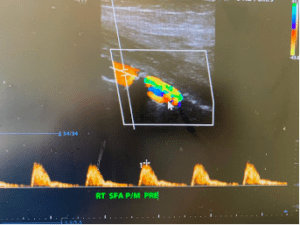
Right Lower Extremity Angiogram
- Right lower extremity angiogram demonstrates high grade, heavily calcified proximal and distal SFA stenoses. Pre-occlusive, irregular mid and distal popliteal artery stenoses are identified with the sluggish flow. High grade, AT origin and moderate TP trunk, and peroneal artery stenoses were identified. PT artery is occluded.
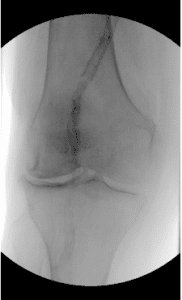
Right Lower Extremity Angiogram

Heavily Calcified Pre-occlusive Mid Popliteal Artery Stenosis

Endovascular Intervention
- Atherectomy of SFA, popliteal and AT, and TP/ peroneal artery stenoses were performed with a 1.25 mm CSI orbital atherectomy device.
- 6mm X 4 cm SMART stent deployed across recoiling distal SFA intrastent stenosis.
- 6mm X 8 cm BIOMIMICS flexible stent deployed across recoiling mid popliteal artery stenosis.
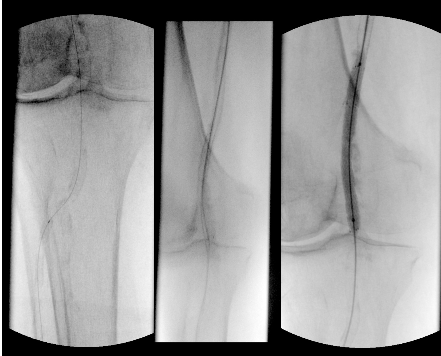
Post Treatment Images
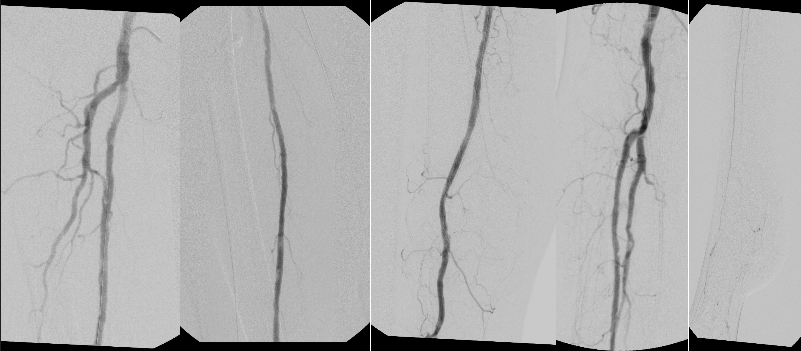
Patient Follow-up
- Rest pain resolved immediately following revascularization. Pt developed mild
hyperperfusion with forefoot and toe swelling following revascularization which
resolved in 1-2 weeks. - She underwent resection of a portion of the toenail with debridement of the nail bed by her podiatrist with complete healing.
Before and After Images

Discussion
- Heavily calcified distal run-off vessel disease may present unique challenges for endovascular treatment.
- A combination of atherectomy with supplemental angioplasty and stenting of recoiling stenoses is the mainstay of treatment of these lesions in our practice.
- Newer technologies, such as SHOCK WAVE angioplasty, may revolutionize treatment of these lesions over the next several years.
Related Blogs & Videos
Learn more about vascular health, prevention, and care for Peripheral Artery Disease.




